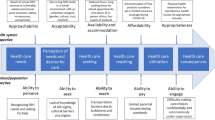Abstract
Local health departments (LHDs) are an important source for screening and treating sexually transmitted diseases (STDs) in rural communities. Yet, they oftentimes lack the resources needed to adequately assess and monitor these conditions. The purpose of this study was to (1) explore how rural LHDs assess and monitor STDs; (2) identify barriers to effective surveillance; (3) examine STD patterns in their communities; and (4) provide recommendations for improving surveillance. Data were collected from questionnaires, LHD site visits, client management system records, and state reports. One of the greatest challenges to adequately monitoring STDs was the lack of standardized data collection methods among LHDs. In addition, race/ethnicity information, which is critical to monitoring disparities, was lacking in most records. Among records where recorded, racial/ethnic minorities were most affected. STD patterns indicated adolescents lead all age groups in STDs. LHDs should consider regionalized or statewide approaches to assessing and monitoring STDs and develop standardized STD interview/intake forms, paying particular attention to race, ethnicity, and income data. Demographic and coding variables should be included and standardized across all forms for consistency. STD interventions and campaigns targeting adolescents and racial/ethnic minorities in rural counties should also be considered. Due to limited time and resources, little can be done by rural LHDs in regards to prevention and education, yet, state and federal agencies should consider how additional resources and enhanced support could be provided to assist them in fulfilling their public health role in STD surveillance.
Similar content being viewed by others
References
U.S. Department of Health and Human Services 2010. (2000). Healthy people 2010: Understanding and improving health. Washington, DC: U.S. Government Printing Office.
American Social Health Association. (1998). Sexually transmitted diseases in America: How many cases and at what cost? Research Triangle Park, NC: American Social Health Association.
Weinstock, H., Berman, S., & Cates, W., Jr. (2004). Sexually transmitted diseases among American youth: Incidence and prevalence estimates, 2000. Perspectives on Sexual and Reproductive Health, 36(1), 6–10.
Institute of Medicine, Committee on Prevention and Control of Sexually Transmitted Diseases. (1997). In: Eng TR, Butler WT (Eds), The hidden epidemic: Confronting sexually transmitted diseases. Washington, DC: National Academy Press.
Roberts, L. W., Johnson, M. E., Brems, C., & Warner, T. D. (2007). Ethical disparities: Challenges encountered by multidisciplinary providers in fulfilling ethical standards in the care of rural and minority people. The Journal of Rural Health, 23, S89–S97.
Kansas Department of Health and Environment, Bureau of Local and Rural Health. (2008). Primary Care Health Professional Underserved Areas Report. Topeka, KS: Kansas Department of Health & Environment. http://www.kdheks.gov/olrh/download/PCUARpt.pdf.
Hart, L. G., Salsberg, E., Phillips, D. M., & Lishner, D. M. (2002). Rural health care providers in the United States. The Journal of Rural Health, 18, S211–S232.
Center for Disease Control and Prevention, Office of the Director, Office of the Chief of Public Health Practice. (2009). National Public Health Performance Standards Program. http://www.cdc.gov/od/ocphp/nphpsp/EssentialPublicHealthServices.htm#es1.
National Association of County & City Health Officials (NACCHO). (2007). Statement of policy: Local health department epidemiology and surveillance capacities; No. 04-11. http://www.naccho.org/advocacy/positions/upload/04-11revLocalepicapacity.pdf.
Kansas Department of Health and Environment (KDHE), Bureau of Local & Rural Health. (2008). Meeting essential services and increasing core competencies: A training model for Kansas. Topeka, KS: KDHE. http://www.kdheks.gov/olrh/essentialservcies/ApplicationModel.pdf.
Paschal, A. M., Kimminau, K., & Starrett, B. (2006). Using a community-based participatory approach to enhance health data skills among local public health community partners. Journal of Public Health Management and Practice, 12(6), 529–535.
Paschal, A. M., Oler-Manske, J., Kroupa, K., & Snethen, E. (2008). Using a community-based participatory research approach to improve the performance capacity of local health departments: The Kansas immunization technology project. Journal of Community Health, 33(6), 407–416.
Whitener, L., Van Horne, V. V., & Gauthier, A. K. (2005). Health services research tools for public health professionals. American Journal of Public Health, 95, 204–207.
Kansas Department of Health and Environment (KDHE), Bureau of Epidemiology and Disease Prevention. (2009). Sexually transmitted disease program: Kansas STD statistics. Topeka, KS: KDHE. http://www.kdheks.gov/std/download/std_reports/FH_2009_STAT_Pack.pdf.
Kansas Department of Health and Environment (KDHE), Bureau of Epidemiology and Disease Prevention. (2008). Kansas STD Report, January–December 2008. Topeka, KS: KDHE. http://www.kdheks.gov/std/download/std_reports/2008_STAT_Pack.pdf.
U.S. Census. Department of Commerce, Bureau of the Census. (2000). American fact finder. http://factfinder.census.gov. Accessed 8 Feb 2010.
KIPHS, Inc. (2010). http://www.kiphs.com.
Centers for Disease Control and Prevention. (2006). Sexually transmitted diseases treatment guidelines. MMWR Morbidity and Mortality Weekly; 55:RR-11.
Yan, A. F., Chiu, Y., Stoesen, C. A., & Stoesen, M. Q. (2007). STD-/HIV-related sexual risk behaviors and substance use among U.S. rural adolescents. Journal of the National Medical Association, 99, 1386–1394.
Wellever A. (2004). Is the Health care system sustainable in rural Kansas. Forum Brief: Kansas Health Policy Forums. Topeka, KS: Kansas Health Institute.
Acknowledgments
The project team members thank the local health departments’ Administrators and staff for their contributions to the study. Their willingness to examine the issue of STDs in their communities and to extend their time, data, and support are greatly appreciated. The project team members would also like to thank the Kansas Health Foundation for its support of this project.
Author information
Authors and Affiliations
Corresponding author
Rights and permissions
About this article
Cite this article
Paschal, A.M., Oler-Manske, J. & Hsiao, T. The Role of Local Health Departments in Providing Sexually Transmitted Disease Services and Surveillance in Rural Communities. J Community Health 36, 204–210 (2011). https://doi.org/10.1007/s10900-010-9298-6
Published:
Issue Date:
DOI: https://doi.org/10.1007/s10900-010-9298-6




